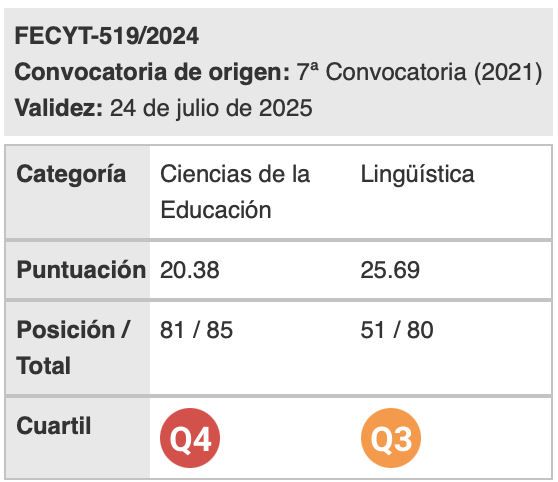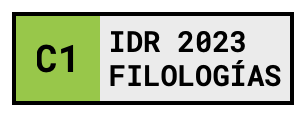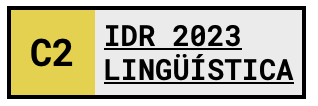Developments in ESP: from register analysis to a genre-based and CLIL-based approach
Palabras clave:
ESP, needs analysis, register, genre, CLILResumen
English for Specific Purposes (ESP) has developed in the last five decades in response to learners’ communicative needs in specific scientific fields and professional settings. Since its emergence in the 1960s the number of publications on ESP has spread both on a theoretical and practical basis, although the bulk of the research has focused on ESP pedagogy, syllabus, course design and classroom-based practice. The present paper aims to trace the evolution of ESP from the beginning of the movement in the mid-1960s to the present day. We will see that the major ESP developments are in consonance with developments in the fields of theoretical and applied linguistics. In this light, four phases can be distinguished: (1) mid-1960 – early 1970s; (2) mid-1970s – mid-1980s; (3) mid-1980s – 1990s; (4) 2000–present. Another outstanding development in ESP is related to the predominance of the different ESP strands. While English for Science and Technology was dominant in early ESP, today English for Academic Purposes and Business English are the largest areas of activity.Descargas
Citas
Alcaraz-Varó, E. (2000). El inglés profesional y académico. Madrid: Alianza Editorial.
Alcaraz, E., Mateo, J. & Yus, F. (Eds.) (2007). Las lenguas profesionales y académicas. Barcelona: Ariel.
Allen, J. P. B. (1978). Teaching the communicative use of English. In R. Mackay & A. Mountford (Eds.), English for Specific Purposes (pp. 56-77). London: Longman.
Allen, J. P. B. & Widdowson, H.G. (1974). English in Focus. Oxford: Oxford University Press.
Allwright, J. & Allwright, M. (1977). An approach to the teaching of medical English. In S. Holden (Ed.), English for Specific Purposes (pp. 58-62). Oxford: Modern English Publications.
Anthony, L. (1997). English for Specific Purposes: What does it mean? Why is it different? ON-CUE, 4 (3), 9-10.
Bailey, S. (2003). Academic Writing. London: Routledge.
Barber, C. L. (1962). Some measurable characteristics of modern scientific prose. In J.M. Swales (Ed.) (1988), Episodes in ESP: A Source and Reference Book on the Development of English for Science and Technology (pp. 3-14). New York: Prentice-Hall.
Bates, M. & Dudley-Evans, T. (1976). Nucleus. English for Science and Technology. London: Longman.
Bazerman, C. (1988). Shaping Written Knowledge. Madison, Wisconsin: University of Wisconsin Press.
Belcher, D. (2004). Trends in teaching English for Specific Purposes. Annual Review of Applied Linguistics, 24, 165-186.
Belcher, D. (Ed.) (2009). English for Specific Purposes: Theory and Practice. Ann Arbor: University of Michigan Press.
Berkenkotter, C., Huckin, T.N. & Ackerman, J. (1991). Social contexts and socially constructed texts: the initiation of a graduate student into a writing research community. In C. Bazerman & J. Paradis (Eds.), Textual Dynamics of the Professions. Historical and Contemporary Studies of Writing in Academic and Other Professional communities (pp. 191-215). Madison, Wisconsin: University of Wisconsin Press.
Berkenkotter, C. & Huckin, T.N. (1995). Genre Knowledge in Disciplinary Communication: Cognition, Culture, Power. Hillsdale, N.J.: L. Erlbaum Associates.
Bhatia, V. K. (1993). Analysing Genre: Language Use in Professional Settings. London: Longman.
Bhatia, V. K. (2004). Worlds of Written Discourse: A Genre-Based View. London: Continuum.
Bhatia, V. K. (2008). Genre analysis, ESP and professional practice. English for Specific Purposes, 27 (2), 161-174.
Biber, D., Connor, U. & Upton, T.A. (2007). Discourse on the Move, Using Corpus Analysis to Describe Discourse Structure. Amsterdam/Philadelphia: John Benjamins.
Bocanegra, A., Lario de Oñate, M.C. & López, E. (Eds.) (2007). English for Specific Purposes: Studies for Classroom Development and Implementation. Cádiz: Universidad de Cádiz.
Bocanegra, A. (2010). Evaluating and designing materials for the ESP classroom. In M.F. Ruiz, J.C: Palmer & I. Fortanet (Eds.), English for Professional and Academic Purposes (pp. 141-166). Amsterdam/New York: Rodopi.
Bosio, I., Castel, V., Ciapuscio, G., Cubo, L. & Muller, G. (Eds.) (2012). Discurso especializado: Estudios teóricos y aplicados. Mendoza: Sociedad Argentina de Lingüística y Editorial de la Facultad de Filosofía y Letras, Serie Volúmenes temáticos de la Sociedad Argentina de Lingüística.
Candlin, C. N., Kirkwood, J.M. & Moore, H. M. (1978). Study skills in English: theoretical issues and practical problems. In R. Mackay & A. Mountford (Eds.), English for Specific Purposes (pp. 190-219). London: Longman.
Carver, D. (1983). Some propositions about ESP. The ESP Journal, 2, 131-137.
Chamberlain, D. & Baumgardner, R.J. (Eds.) (1987). ESP in the Classroom. Practice and Evaluation. London: Macmillan.
Chambers, F. (1980). A re-evaluation of needs analysis. ESP Journal, 1 (1), 25-33.
Close, R. A. (1965). The English We Use for Science. London: Longman.
Connor, U. (1996). Contrastive Rhetoric: Cross-cultural Aspects of Second Language Writing. Cambridge: Cambridge University Press.
Connor, U., Nagelhout, E. & Rozycki, W. (Eds.) (2008). Contrastive Rhetoric: Reaching to Intercultural Rhetoric. Amsterdam/Philadelphia: John Benjamins.
Coyle, D., Hood, P. & Marsh, D. (2010). Content and Language Integrated Learning. Cambridge: Cambridge University Press.
Crookes, G. (1986). Task Classification: A Cross-disciplinary Review. Center for Second Language Classroom Research, Social Science Research Institute, University of Hawaii at Manoa.
Dafouz, E. & Guerrini, M.C. (Eds.) (2009). CLIL across Educational Levels. Experiences from Primary, Secondary and Tertiary Contexts. Madrid: Richmond Santillana.
Dalton-Puffer, C. (2011). CLIL: From practice to principles? Annual Review of Applied Linguistics, 31, 182-204.
De Silva, H. & Hood, S. (2009). English for community membership. Planning for factual and potential needs. In D. Belcher (Ed.), English for Specific Purposes: Theory and Practice (pp. 244-263). Ann Arbor: University of Michigan Press.
Doiz, A., Lasagabaster, D. & Sierra, J.M. (Eds.) (2013). English-medium Instruction at University. Global Challenges. Bristol: Multilingual Matters.
Dudley-Evans, T. (1977). Planning a course for science and engineering students. In S. Holden (Ed.), English for Specific Purposes (pp. 38-40). Oxford: Modern English Publications.
Dudley-Evans, T. (1988). Recent developments in ESP: The trend to greater specialization. In M. L. Tickoo (Ed.), ESP: State of the Art (pp. 27-32). Singapore: SEAMEO Regional English Language Centre.
Dudley-Evans, T. (1995). Common core and specific approach to the teaching of academic writing. In D. Belcher & G. Braine (Eds.), Academic Writing in a Second Language (pp. 293-312). Norwood, N.J.: Ablex.
Dudley-Evans, T. & St John, M.J. (1998). Developments in English for Specific Purposes: A Multidisciplinary Approach. Cambridge University Press.
Eckerley, C. & Knufmann, W. (1973). English for Business. Oxford: Oxford University Press.
Eggins, S. & Martin, J.R. (1997). Genres and registers of discourse. In T. A. van Dijk (Ed.), Discourse as Structure and Process (pp. 230-256). London: Sage.
Ellis, M. & Johnson, C. (1994). Teaching Business English. Oxford: Oxford University Press.
English for Business: Bellcrest File. A. Drummond. 1972. Oxford: Oxford University Press.
Ewer, J. & Latorre, G. (1967) Preparing an English Course for Students of Science. English Language Teaching, 21, 221-229.
Ewer, J. & Latorre, G. (1969). A Course in Basic Scientific English. London: Longman.
Fernández, D. J. (2009). CLIL at the university level: Relating language teaching with and through content teaching. Latin American Journal of Content and Language Integrated Learning, 2 (2), 10-26.
Fløttum, K., Dahl, T. & Kinn, T. (2006). Academic Voices across Languages and Disciplines. Amsterdam/Philadelphia: John Benjamins.
Flowerdew, L. (2000). Using a genre-based framework to teach organizational structure in academic writing. ELT Journal, 54 (4), 369-78.
Focus series. 1977-1983. Oxford: Oxford University Press.
Fortanet, I. (2013). CLIL in Higher Education. Towards a Multilingual Language Policy. Bristol: Multilingual Matters.
Fortanet, I. & Räisänen, C.A. (2008). The state of ESP teaching and learning in western European higher education after Bologna. In I. Fortanet & C.A. Räisänen (Eds.), ESP in European Higher Education. Integrating Language and Content (pp. 11-51). Amsterdam/Philadelphia: John Benjamins.
Fortanet, I. & Räisänen, C.A. (Eds.) (2008). ESP in European Higher Education. Integrating Language and Content. Amsterdam/Philadelphia: John Benjamins.
Garcés-Conejos, P. (2010). Who ‘we’ are: the construction of American corporate identity in the Corporate Values Statement genre. In M.F. Ruiz, J.C. Palmer & I. Fortanet (Eds.), English for Professional and Academic Purposes (pp. 121-137). Amsterdam/New York: Rodopi.
García-Mayo, P. (2000). English for Specific Purposes: Discourse Analysis and Course Design. Servicio Editorial de la Universidad del País Vasco.
Gavioli, L. (2005). Exploring Corpora for ESP Learning. Amsterdam/ Philadelphia: John Benjamins.
González-Pueyo, I., Foz, C., Siso, M. & Luzón, M.J. (Eds.) (2009). Teaching Academic and Professional English Online. Bern: Peter Lang.
Gotti, M. & Giannoni, D.S. (Eds.) (2006). New Trends in Specialized Discourse Analysis. Bern: Peter Lang.
Halliday, M. A. K., McIntosh, A. & Strevens, P. (1964). The Linguistic Sciences and Language Teaching. London: Longman.
Herbert, A. J. (1965). The Structure of Technical English. London: Longman.
Hopkins, A. & Dudley-Evans, T. (1988). A genre-based investigation of the discussion sections in articles and dissertations. English for Specific Purposes, 7 (2), 113-121.
Huddleston, R. D., Hudson, R.A., Winter, E.O. & Henrici, A. (1968). Sentence and Clause in Scientific English, mimeo. London: Communication Research Centre, Department of General Linguistics, University College.
Huhta, M. et al. (2013). Needs Analysis for Language Course Design: A Holistic Approach to ESP. Cambridge University Press.
Hutchinson, T. (1987). Making materials work in the ESP classroom. In D. Chamberlain & R. J. Baumgardner (Eds.), ESP in the Classroom. Practice and Evaluation (pp. 71-75). London: Macmillan.
Hutchinson, T. & Waters, A. (1987). English for Specific Purposes. Cambridge University Press.
Hyland, K. (2000). Disciplinary Discourses: Social Interactions in Academic Writing. London: Longman.
Hyland, K. (2004). Genre and Second Language Writing. Ann Arbor: University of Michigan Press.
Hyland, K. (2006). English for Academic Purposes. London: Routledge.
Hyland, K. & Bondi, M. (Eds.) (2006). Academic Discourse across Disciplines. Bern/New York: Peter Lang.
Johns, A. (2009). Tertiary undergraduate EAP: Problems and possibilities. In D. Belcher (Ed.), English for Specific Purposes: Theory and Practice (pp. 41-59). Ann Arbor: University of Michigan Press.
Johns, A. M. & Dudley-Evans, T. (1993). English for specific purposes: International in scope, specific in purpose. In S. Silberstein (Ed.), State of the Art TESOL Essays: Celebrating 25 Years of the Discipline (pp. 115-132). Alexandria: TESOL.
Johnson, K. A. (2000). Communication skills for international pharmacy students. In P. Master (Ed.), Responses to English for Specific Purposes (pp. 138-141). Washington, D.C.: Bureau of Educational and Cultural Affairs.
Jordan, R. R. (1997). English for Academic Purposes: A Guide and Resource Book for Teachers. Cambridge: Cambridge University Press.
Kennedy, C. & Bolitho, R. (1984). English for Specific Purposes. London: Macmillan.
Kerr, L. (1977). English for Special Purposes. In S. Holden (Ed.), English for Specific Purposes (pp. 11-12). Oxford: Modern English Publications.
Khuwaileh, A. (1993). ESP after 30 years. An overview of the position of ESP in the 1990s. Unesco ALSED-LSP Newsletter, 15 (1), 23-31.
Lackstrom, J., Selinker, L. & Trimble, L. (1970). Grammar and technical English. In R.C. Lugton (Ed.), English as a Second Language: Current Issues. Center for Curriculum Development, Chilton. Reprinted in English Teaching Forum, 1972, pp. 3-14.
Longman Business English Skills. 1987. London: Longman.
Luzón, M. J., Ruiz-Madrid, M.N. & Villanueva, M.L. (2010). Digital Genres, New Literacies and Autonomy in Language Learning. Newcastle upon Tyne, UK: Cambridge Scholars Publishing.
Mackay, R. & Mountford, A. (Eds.) (1978). English for Specific Purposes. London: Longman.
Maljers, A., Marsh, D. & Wolff, D. (Eds) (2007). Windows on CLIL: Content and Language Integrated Learning in the European Spotlight. Berlin: Mouton de Gruyter.
Market Leader. Pearson Longman.
Marsh, D. (2006). English as a medium of instruction in the new global linguistic landscape. UniCOM: 29-38.
Master, P. (Ed.) (2000). Responses to English for Specific Purposes. Washington, D.C.: Bureau of Educational and Cultural Affairs.
McDonough, J. (1984). ESP in Perspective: A Practical Guide. London: Collins ELT.
Melander, B. (1998). Culture or genre Issues in the interpretation of cross-cultural differences in scientific articles. In I. Fortanet, S. Posteguillo, J. C. Palmer & J. F. Coll (Eds.), Genre Studies in English for Academic Purposes (pp. 221-26). Castellón: Publicacions de la Universitat Jaume I.
Myers, G. (1990). Writing Biology. Texts in the Social Construction of Scientific Knowledge. Madison, Wisconsin: University of Wisconsin Press.
Mehisto, P, Marsh, D. & Frigols, M.J. (2008). Uncovering CLIL. Content and Language Integrated Learning in Bilingual and Multilingual Education. London: Macmillan.
Moore, J. (1980). Reading and Thinking in English. Oxford: Oxford University Press.
Munby. J. (1978). Communicative Syllabus Design. Cambridge; Cambridge University Press.
Nucleus series. Eds. M. Bates & J. Dudley-Evans. 1976. London: Longman.
Orr, T. (Ed.) (2002). English for Specific Purposes. Alexandria: TESOL.
Paltridge, B. (2001). Genre and the Language Learning Classroom. Ann Arbor: University of Michigan Press.
Piqué, J. & Viera, D.J. (Eds.) (1997). Applied Languages: Theory and Practice in ESP. València: Universitat de València.
Robinson, P. (1991). ESP Today: A Practitioner’s Guide. NewYork/London: Prentice Hall.
Ruiz, M. F., Palmer, J.C. & Fortanet, I. (2010). Current trends in English for Professional and Academic Purposes. In M.F. Ruiz, J.C. Palmer & I. Fortanet (Eds.), English for Professional and Academic Purposes (pp. 1-10). Amsterdam/New York: Rodopi.
Ruiz, M.F., Palmer, J.C. & Fortanet, I. (Eds.) (2010). English for Professional and Academic Purposes. Amsterdam/New York: Rodopi.
Ruiz de Zarobe, Y. & Jiménez, R. (2009). Content and Language Integrated Learning: Evidence from Research in Europe. Clevedon: Multilingual Matters.
Ruiz de Zarobe, Y., Sierra, J.M. & Gallardo del Puerto, F. (Eds.) (2011). Content and Foreign Language Integrated Learning. Contributions to Multilingualism in European Contexts. Bern: Peter Lang.
Salager-Meyer, F., Defives, G., Jensen, C. & de Filipis, M. (1989). Principal component analysis and medical English discourse: An investigation into genre-analysis. System, 17 (1), 21-34.
Sales, H. E. (2006). Professional Communication in Engineering. Basingtoke, New York: Palgrave Macmillan.
Skills for Learning (Foundation, Progression, Development, Reading Projects: Science). 1980. Nelson and the University of Malaya Press.
Selinker, L., Lackstrom, J. & Trimble, L. (1973). Technical rhetorical principles and grammatical choice. TESOL Quarterly, 7 (2), 127-136.
Selinker, L., Trimble, L. & Vroman, R. (1974). Presupposition and technical rhetoric. English Language Teaching Journal, 29 (1), 59-65.
Selinker, L., Todd Trimble, M. & Trimble, L. (1976). Presuppositional rhetorical information in EST discourse. TESOL Quarterly, 10 (3), 281 – 290.
Selinker, L, Todd Trimble, M. & Trimble, L. (1978). Rhetorical function shifts in EST discourse. TESOL Quarterly, 12 (3), 311-320.
St John, M. J. (1996). Business is booming: BE in the 1990s. English for Specific Purposes, 15, 3-18.
Smit, U. & Dafouz, E. (2012). Integrating Content and Language in Higher Education. AILA Review, 25, 1-12.
Strevens, P. (1977). Special purpose language learning: A perspective. Language Teaching and Linguistic Abstracts, 10, 145-163.
Strevens, P. (1988). ESP after twenty years: A re-appraisal. In M.L.Tickoo (Ed.), ESP: State of the Art (pp. 1-13). Singapore: SEAMEO Regional English Language Centre.
Sturtridge, G. (1977). Using simulation in teaching English for Specific Purposes. In S. Holden (Ed.), English for Specific Purposes (pp. 32-34). Oxford: Modern English Publications.
Suomela-Salmi, E. & Dervin, F. (Eds.). (2009). Cross-cultural and Cross-Linguistic Perspectives on Academic Discourse. Amsterdam/Philadelphia: John Benjamins.
Swales, J. M. (1971). Writing Scientific English. London: Nelson.
Swales, J. M. (1981). Aspects of Article Introductions. Aston ESP Research Reports. Birmingham: Language Studies Unit, University of Aston.
Swales, J. M. (1988). A genre-based approach to language across the curriculum. In M.L. Tickoo (Ed.), ESP: State of the Art (pp. 10-22). Singapore: SEAMEO Regional English Language Centre.
Swales, J. M. (1988). Discourse communities, genres and English as an international language. World Englishes, 7 (2), 211-220.
Swales, J. M. (1990). Genre Analysis. Cambridge: Cambridge University Press.
Swales, J. M. (2004). Research Genres: Exploration and Applications. Cambridge: Cambridge University Press.
Swales, J. M. (2007). Genre Analysis. English in Academic and Research Settings. Cambridge: Cambridge University Press.
Swales, J. M. & Feak, C.B. (1994). Academic Writing for Graduate Students: Essential Tasks and Skills. A Course for Non-Native Speakers of English. Second edition. Ann Arbor, M.I: University of Michigan Press.
Trimble, L. (1985). English for Science and Technology: A Discourse Approach. Cambridge: Cambridge University Press.
Wheeler, M. (1977). The role of games, simulations and role-playing exercises in language training for specific purposes. In S. Holden (Ed.), English for Specific Purposes (pp. 34-35). Oxford: Modern English Publications.
Widdowson, H. G. (1975). EST in theory and practice. E.T.I.C. Occasional Paper 1975. Oxford: The British Council.
Widdowson, H. G. (1978). Teaching Language as Communication. Oxford: Oxford University Press.
Widdowson, H. G. (1983). Learning Purpose and Language Use. Oxford: Oxford University Press.
Wilkinson. R. (2008). Locating the ESP space in problem-based learning. In I. Fortanet & C.A. Räisänen (Eds.), ESP in European Higher Education. Integrating Language and Content (pp. 55-73). Amsterdam/Philadelphia: John Benjamins.
Wilkinson, R. & Zegars, V. (Eds.) (2007). Researching Content and Language Integration in Higher Education. Maastricht: Maastricht University Language Centre.
Wolff, D. & Marsh, D. (2007). Diverse Contexts – Converging Goals. Content and Language Integrated Learning in Europe. Vol. 4. Frankfurt: Peter Lang.
Descargas
Publicado
Cómo citar
Número
Sección
Licencia
Aquellos autores/as que tengan publicaciones con esta revista, aceptan los términos siguientes:
- Los autores/as conservarán sus derechos de autor y garantizarán a la revista el derecho de primera publicación de su obra, el cuál estará simultáneamente sujeto a la Licencia de reconocimiento de Creative Commons que permite a terceros compartir la obra siempre que se indique su autor y su primera publicación esta revista.
- Los autores/as podrán adoptar otros acuerdos de licencia no exclusiva de distribución de la versión de la obra publicada (p. ej.: depositarla en un archivo telemático institucional o publicarla en un volumen monográfico) siempre que se indique la publicación inicial en esta revista.
- Se permite y recomienda a los autores/as difundir su obra a través de Internet (p. ej.: en archivos telemáticos institucionales o en su página web) antes y durante el proceso de envío, lo cual puede producir intercambios interesantes y aumentar las citas de la obra publicada. (Véase El efecto del acceso abierto).

Revista de Lenguas para fines específicos is licensed under a Creative Commons Reconocimiento-NoComercial-SinObraDerivada 4.0 Internacional License.






















